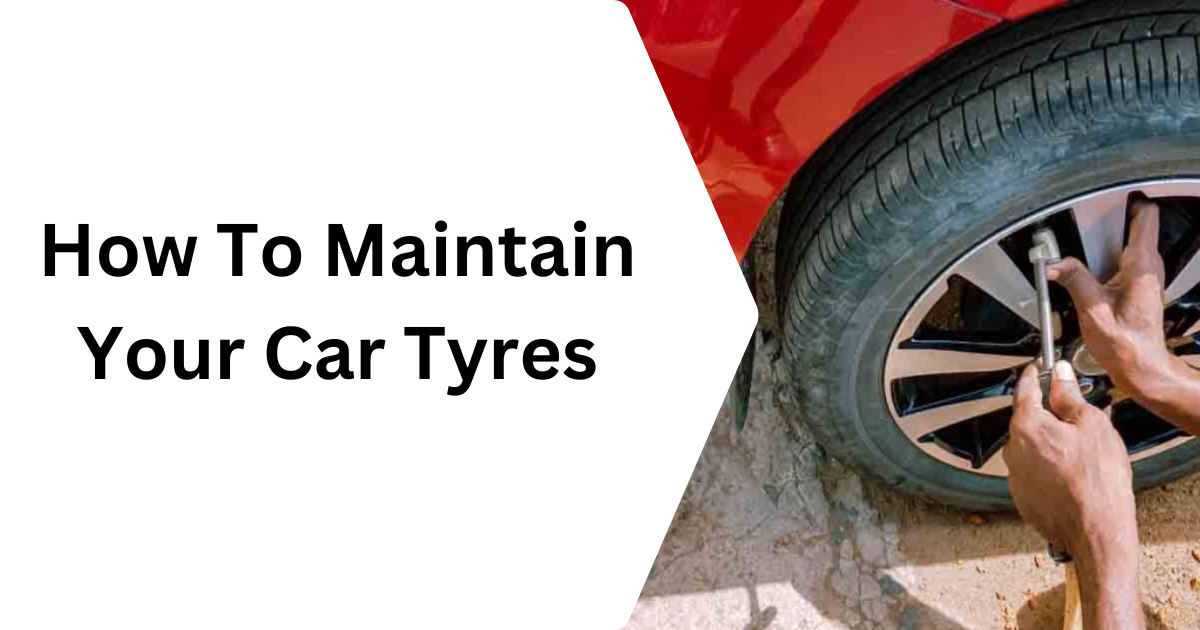Looking after your tyres is about safety and ensuring they last as long as possible. Knowing how to maintain your car tyres plays a big part in this. Many things can make your tyres wear out faster, like bad roads, low or high tyre pressure, and rough driving. Proper care can help you avoid these problems and keep your tyres in good shape for a long time. Let’s discuss 7 effective ways to maintain the longevity of your tyres.
Check Tyre Pressure Regularly
When your tyres are under-inflated, they wear out faster and make your car use more fuel. On the other hand, over-inflated tyres can lead to less grip on the road, especially on wet surfaces, making driving more dangerous.
Each vehicle has its specifications for tyre pressure, but most fall between 28 and 36 PSI (pounds per square inch). However, this could be higher if you carry extra load in your vehicle or use tyres with a larger diameter. It’s a good habit to check your tyre pressure at least once a month and before long trips. A simple tyre pressure gauge is available at most petrol stations or mechanic shops. Always follow the recommended pressure for your car, which is usually listed in your vehicle manual or on a sticker inside the driver’s door.
Align Your Tyres
It’s recommended to have your tyres aligned every 6,000 to 10,000 kilometers or whenever you notice handling issues. Misalignment can happen quickly, especially on our rough roads, when you hit a pothole or a bump too hard. If you see your car pulling to one side while driving or your steering wheel vibrating, it’s a sign that your tyres may need alignment. Other signs of misalignment include:
- Your car is pulling to the left or right slightly as you drive
- The steering wheel is off-center as you drive straight
- The steering wheel vibrates as you drive
- The steering wheel doesn’t centralize after performing a turn
- Loose handling
- Uneven tyre wear
- Squealing noise from tyres
Regular alignment checks help keep your tires properly positioned, extending their lifespan and supporting better fuel efficiency. Proper alignment also ensures smooth handling, which not only keeps you safer on the road but also supports the long-term maintenance of your vehicle by reducing stress on suspension and steering components.
Rotate Your Tyres
It’s recommended to rotate your tyres every 8,000 to 10,000 kilometers or as advised in your car’s manual. During a rotation, the tyres are swapped between different positions, such as moving the front tyres to the rear and vice versa. This simple practice helps balance the wear, improves vehicle handling, and ensures all tyres wear at the same rate. Keeping up with tyre rotation can save you money and improve your car’s performance on the road.
Puncture Check Maintenance
Checking your tyres for punctures is an integral part of tyre maintenance. Small punctures, like those caused by nails or sharp objects, can lead to slow leaks that may go unnoticed until your tyre is flat. Regularly inspecting your tyres for any signs of punctures or damage can help avoid getting stranded on the road.
If you spot a nail or other object stuck in your tyre, don’t pull it out yourself. Instead, visit a mechanic or tyre shop to get it checked and repaired correctly. Sometimes, a simple repair can fix the issue, but in other cases, the tyre may need to be replaced.
Timely Tyre Replacement
Knowing when to replace your tyres is essential for safe driving. No matter how well you care for your tyres, they will eventually wear out and lose effectiveness. Worn tyres can reduce grip, especially on wet roads, and increase the risk of accidents. Most tyres last between three to five years, depending on usage, but it’s essential to check regularly for signs that need replacing.
Some clear signs that it’s time to replace your tyres include worn-out tread, visible sidewall cracks, or if the tyre is older than five years. If you notice your car isn’t handling well, or your stopping distance has increased, it may be time for new tyres. Replacing your tyres at the right time keeps you safe and helps maintain your vehicle’s performance.
Be Mindful of Road Debris
Driving on Nigerian roads can be tricky, with potholes, sharp objects, and debris often threatening your tyres. Being mindful of these road hazards is important to keep your tyres in good condition. Hitting a pothole or driving over sharp objects like broken glass can cause punctures, damage the sidewalls, or even lead to a blowout, which can be dangerous.
To protect your tyres, avoid potholes whenever possible, slow down on rough roads, and watch for sharp objects. If you do hit a pothole, it’s a good idea to check your tyres afterward for damage. Being cautious on the road can go a long way toward extending the life of your tyres and preventing unexpected breakdowns.
Store Your Tyres Well
Proper tyre storage is crucial if you need to keep them off your vehicle for an extended period, such as when switching between regular and seasonal tyres. Storing your tyres the right way helps prevent damage and extends their lifespan. When tyres are not stored properly, they can develop cracks, lose shape, or weaken over time.
To store your tyres well, keep them in a cool, dry place away from direct sunlight, as heat can cause the rubber to deteriorate. Store them vertically and avoid stacking them on each other for long, if possible. Ensure they’re clean and free of dirt or debris before storing them and use tire covers if available.
Seek Professional Help
While regular maintenance can go a long way, there are times when it’s best to consult a professional for your tyre care. If you’re unsure about the condition of your tyres, notice unusual vibrations while driving, or experience issues like rapid wear or punctures, a professional mechanic or tyre expert can help. They have the tools and expertise to check your tyres thoroughly and recommend the best course of action, whether repairing a puncture, aligning your wheels, or replacing worn-out tyres.
Don’t wait until a minor issue becomes a big problem. Regular check-ups from a professional can help you catch potential hazards early and ensure your tyres are always in top condition for safe driving.
FAQs
1. How do you maintain tires?
Maintaining tires involves checking their pressure regularly, rotating them every 5,000–7,000 miles, and inspecting for signs of wear or damage. Keeping the tires at the recommended pressure improves fuel efficiency, reduces uneven wear, and helps prevent blowouts. Routine inspections also help you spot issues early, such as cracks, low tread, or bulges, so you can replace or repair tires before they become unsafe.
2. How can I make my tires last longer?
To make your tires last longer, drive smoothly by avoiding rapid acceleration, harsh braking, and sharp turns, as these can wear down tire tread faster. Additionally, have your wheels aligned and balanced during regular maintenance to ensure even wear on all tires. Proper alignment, along with regular tire rotation, helps tires wear evenly and last longer.
3. How do you keep car tires in good condition?
Keeping tires in good condition requires monitoring tread depth and ensuring they’re free of damage. Use a tread depth gauge to make sure there’s enough tread for safe driving, as worn-out tread reduces traction, especially in wet conditions. Regular cleaning to remove dirt, chemicals, and debris from the tires can also prevent cracking and prolong their lifespan.
4. How do you protect your car tires?
Protecting your tires starts with parking in shaded areas or using tire covers to prevent sun damage, which can cause cracks and weaken the rubber. Avoiding potholes and rough roads also protects the tire structure from damage. If storing the car for an extended period, consider lifting it off the ground to avoid flat spots that can form from long-term pressure on the same area of the tires.
5. Why is proper tire pressure important?
Proper tire pressure is essential for safe handling, better fuel efficiency, and even wear on all tires. Underinflated tires create more friction with the road, which can lead to overheating and blowouts, while overinflated tires may wear down unevenly and reduce traction. Checking your tire pressure monthly ensures it’s within the recommended range for safe, efficient driving.
6. When should I replace my tires?
Tires generally need replacing when the tread depth reaches 2/32 of an inch, which is the legal minimum in most areas. Additionally, if your tires have noticeable cracks, bulges, or recurring air leaks, it’s time to replace them. Older tires, typically over six years, should also be inspected regularly, as rubber weakens over time, even if tread wear is minimal.




